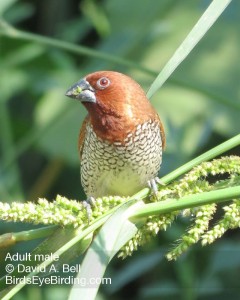Finding Scaly-breasted Munia
Nutmeg Mannikin was added to the ABA list in 2013. As of Aug 2014 their name in Clements/eBird will change to Scaly-breasted Munia to bring our North American terminology into line with that used in the rest of the world. These birds are also called “Spice Finches” in the pet trade. I’m still getting used to the new name so my apologies if I throw a few “Mannikins” into my description below!
In California Scaly-breasted Munia Lonchura punctulata: Scaly-breasted Munias are locally common in San Diego, Ventura, Orange, Riverside, San Bernardino and Los Angeles Counties especially in riparian habitat. They also occur locally in the south San Francisco bay area and a few other scattered locations. They are common in the Houston, TX area. They also occur in Santa Barbara, San Luis Obispo, Riverside and San Bernardino counties, although they are generally less common there.
Scaly-breasted Munias prefer riparian vegetation especially around the edges of water, such as reeds and reeds mixed with grass. They are closely associated with tall seeding grass and other seeding plants. Learning their distinctive calls will make them much easier to find, as they often remain hidden in vegetation and can be inconspicuous.
Scaly-breasted Munias are somewhat seasonal in Southern California, which is a bit odd since they don’t migrate. Munias are easiest to find between June and November and are a bit harder to find between January and April. It appears that at least some of this seasonality is related to dispersal away from breeding areas and changes in habits. Outside of the breeding season, munias tend to stay low in vegetation and are best found by their calls.
Most of the locations described below are allso good places for general birding.
Huntington Beach Central Park: A premier vagrant trap in Southern California. Scaly-breated Munias are one of the most abundant species in the wetter portions of the park, especially in the eastern portion of the park (east of Golden West Blvd). Look for them along the north and east side of the ephemeral lake in the eastern portion of the park. This is perhaps the easiest place to find this species.
San Gabriel River in Pico Rivera: A thriving colony of Norther Red Bishops (formerly known as Orange Bishops) and Scaly-breasted Munias is in the weedy grasses going to seed, upstream side of Whittier Narrows Dam flood control gates. Directions: Park near here. From the parting area, take river trail/bike path north, up and over the dam and down into the river bottom right in front of the gates. This area is often damp and full of seeding grass, and attracts large numbers of seedeaters including buntings, munias, bishops, grosbeaks, blackbirds, towhees and sparrows.
Peck Road Water Conservation Park: A colony of Norther Red Bishops and Scaly-breasted Munias lives at the North End of the lake and also near the narrow canal that separates the North and South Lakes. Note that this area is marked “No trespassing” and also has an active homeless encampment, so enter this area with caution and at your own risk. Do not go alone.
Note that this is a great area to find seedeaters of many types in the fall. A more accessible area to check is west of the main parking lot.
Lower Los Angeles River – the stream side vegetation and reeds both south and north of Willow St are good places to look for Northern Red Bishops and Scaly-breasted Munias in the breeding season.
Ken Malloy Harbor Regional Park (currently CLOSED July 2014) – the reed beds around the edge of the lake host Scaly-breasted Munias, although they are harder to find here than at the locations listed above because they tend to stay in the reeds.
Rio Hondo at Rush St. – the small reed beds in the channel and the riparian edge in the 1/2 mile between Rush and Garvey. Park on Rush Street and walk west to the bike path along the Rio Hondo. Check the riparian edge and the walk north along the bike path.
5 Peters Canyon Rd, Irvine, CA. – Park across the street in the business park areas and walk across the street to the Peters Canyon concrete walled wash that runs parallel to the street and if you walk 100 yards (and typically way less) up stream or down stream and don’t see a Munia, you may have your eyes closed!
Please let me know if you notice anything that needs to be modified on this page.
David Bell 2014

